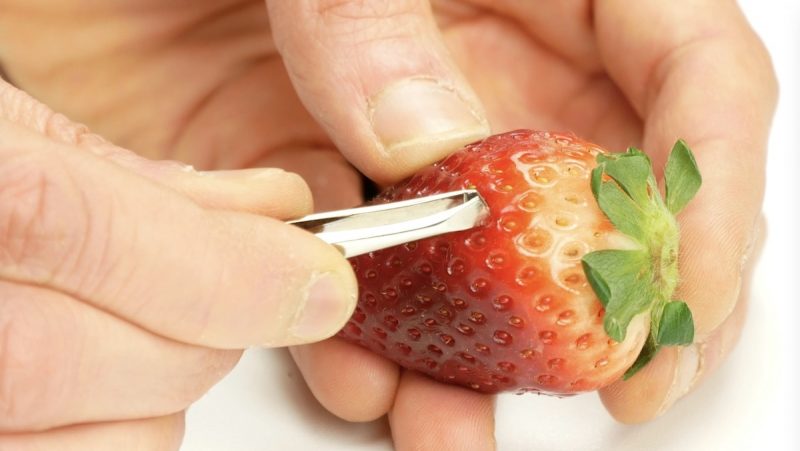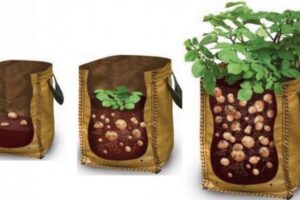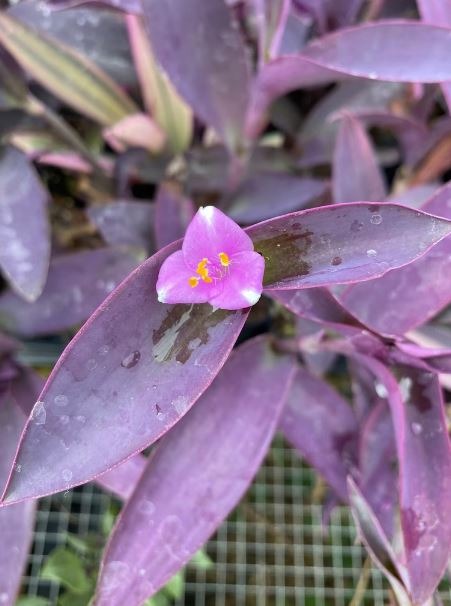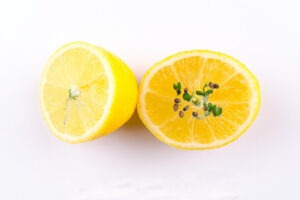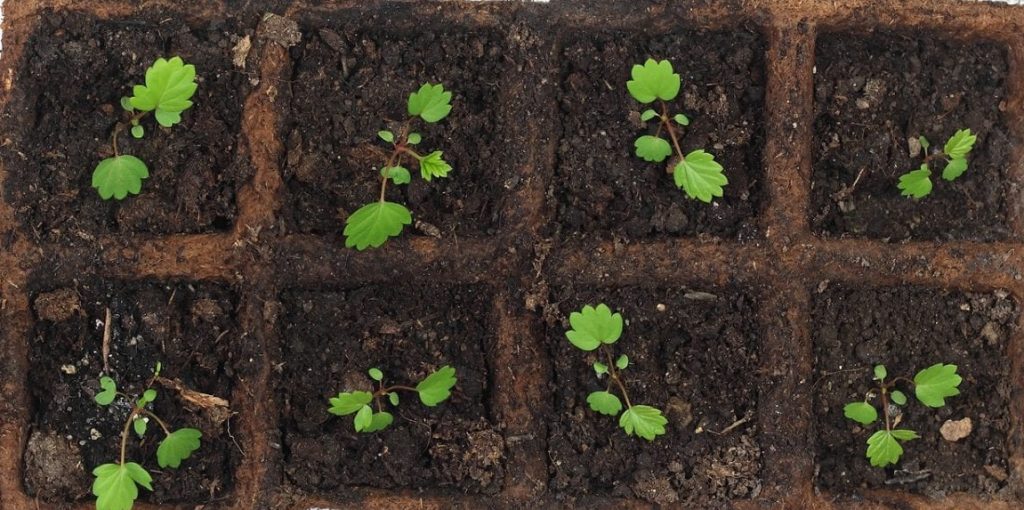
Let’s learn how to grow strawberries from seeds.
Growing Strawberries from seeds is easy if you follow these instructions.
Think about a few things first to prepare your garden or patio for them.
Strawberries grown from seed can be started indoors at home while it is still cold outside.
- Pick a spot for them in your garden. They need lots of sun, so a patio or balcony is a good idea. Keep them handy so you can pick the berries easily too. If you are growing them indoors keep the temperature above 65F or 18.33C.
- Choose a deep pot of 20 cm or 7″ inches for growing strawberry seeds on the patio. A great idea, it’s close at hand and makes it easier to protect your strawberries from birds and slugs. For indoors keep them in a warm sunny spot like a south facing window.
HOW TO GERMINATE STRAWBERRY SEEDS
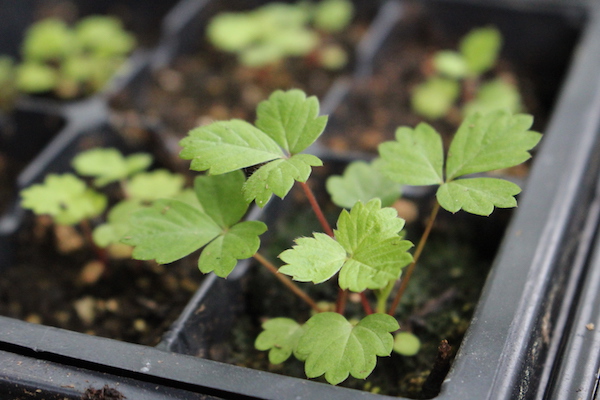
The hardest part of growing strawberries from seed is getting the seeds to germinate in the first place. Most strawberry seeds require cold stratification to germinate, and they won’t break dormancy until they’ve gone through winter-like conditions.
- Strawberries seeds need rich nutritious soil to grow in. They like lots of water but don’t like sitting in puddles so fill your container up with good soil after you make sure you have holes in the bottom for drainage. Strawberries need room to grow so I generally leave 30cm or 12″ inches between plants.
- Once your Strawberry seeds have gone through cold stratification now you are ready to plant and grow them.
- Pick up a bag of seed-raising soil mix from your local garden supply store and pour the soil into a standard-sized seed tray then, bury the seeds about 6 mm (0.24 in) beneath the soil.
- As a general rule of thumb, bury about 2-3 strawberry seeds in each tray or space them apart about 12 inches for larger trays.
- You can buy seed trays online or from your nearest garden supply store.
- Use netting or fleece to protect your developing strawberries from pests. Blackbirds and the like can wipe out a full row in hours so it’s best to protect them so you can taste them yourself.
- Once you’ve planted the strawberry seeds and they have been watered in. All that’s left to do is to sit back with your feet up and wait.
- Strawberry seed germination can take up to 6 weeks. Be patient. Once they emerge they are super growers! Most of the time they will have fruit within the first year or two.
The plants are low growing perennials and provide a delicious supply of fruit either in June (from the appropriately named “June bearers”) or throughout the summer (from the day-neutral types). Plants fruit well in rows, beds, or even in pots, and make an attractive groundcover when not fruiting.
The Strawberry Plant
The strawberry plant is in many ways unique. It is an herbaceous perennial, composed of leaves, a crown (a compressed, modified stem), and a root system (Figure 8.1). In heavier soils such as clay loams, 90 percent of the roots can be located in the top 6 inches of soil. This shallow root system is, in part, responsible for the strawberry plant’s sensitivity to water deficit and excess. Runners, or stolons, arise from buds at the base (axils) of the leaves; they are the strawberry plant’s device for asexual propagation.

Variety Selection
Because strawberry varieties are extremely sensitive to local conditions, a variety that performs well in one location may do poorly in another area. Varieties that perform satisfactorily in northern Pennsylvania might fail miserably in the southern portion.
Because of these differences in variety performance, gardeners are strongly advised to experiment with a number of varieties. Varieties with resistance to red stele and verticillium wilt are highly recommended.
June-bearing Strawberries
The strawberry most commonly grown in Pennsylvania is the June-bearing strawberry. June bearers are the type most often grown by commercial growers, and are the result of decades of breeding for productivity, size, and other attributes. These varieties are rated as early, midseason, or late according to when they bear ( Table 8.1 ). The early varieties may be more subject to frost injury because they bloom earlier, and the opened blossom is the stage of fruit development most susceptible to frost injury. Strawberry varieties all ripen about 30 days after bloom.
Day-neutral Strawberries
Day-neutral strawberry varieties bear throughout the growing season. They are highly productive and have very flavorful berries. Day-neutral plants have three peaks of production each year: one in June, one in midsummer, and one from late August through frost. Day-neutral strawberries have been grown successfully in commercial plantings in Pennsylvania; however, the summer crop often is very small due to high temperatures. The high-temperature effects can be ameliorated by a heavy straw mulch to keep soil temperatures low; however, even with this precaution, day-neutral varieties may not perform well in the southern half of Pennsylvania. Cultural practices for these berries differ from those of June bearers; some of these differences are outlined in subsequent sections of this publication.
Everbearing Strawberries
These varieties bear two crops during the year and generally are not as high in quality or as productive as the day-neutral types. For this reason, we recommend that you plant the day-neutral types rather than the everbearers if continuous cropping is desired. Descriptions in nursery catalogs often refer to day-neutral varieties as everbearers, however, so making this distinction can be difficult. All of the day-neutral varieties discussed in the chapter are true day-neutrals.
How To Grow Strawberries from Seeds Video
Watch how to grow strawberries from seeds instructional video posted by MyGardenChannel on YouTube.
Planting Strawberry Plants
So you have now got to the planting stages.
After all the hard work in learning how to grow strawberries from seeds, now is the time to get them in the ground.
Keep plants in a shady area or refrigerator until planting. Place the roots in water about 1/2 hour prior to planting. Do not allow the roots to dry out during the planting process.
Strawberries should be planted in April, as soon as the soil is in good condition–well worked, without excess moisture. Planting after June 1 is not recommended.
Plant June-bearing strawberries 18 to 24 inches apart in rows at least 36 inches apart with the soil line above the roots but not covering the growing point of the crown.
Day-neutral strawberries should be planted closer together, about 5 to 9 inches apart. Additionally, day-neutral plants should be mulched immediately since they are sensitive to warm soil temperatures.
Mulch with about 4 inches of clean straw. Flower buds of June-bearing strawberries should be removed manually in the first year to avoid flowering and fruiting stress on the young plant.
Strawberry Flowers
Flower buds and runners on the day-neutrals should be removed only through early July of the first year and may be allowed to fruit after this date.
Removing flowers allows the plants to direct their energy into root-system establishment and the development of a healthy, large leaf canopy that will “fuel” the next year’s crop.
The importance of establishing a healthy stand of plants cannot be overemphasized. The planted field should be irrigated immediately.
Optimal soil moisture levels need to be maintained throughout the season so that plants become well established.
/029F7730-B7AC-4B20-9905-BED81872867E_1_201_a-17d3fcffae564f8c9d4d3e4c203b516c.jpeg)
Feeding Strawberry Plants
Apply 2 pounds of 10-10-10 per 100 feet of row after planting and an additional 2 pounds in late August.
Day-neutral varieties should receive a more constant nitrogen rate through the planting year. Apply 1 pound of ammonium nitrate per 100 feet of row once a month from June through the first day of September. Strawberry size can be increased dramatically by timely irrigation as the berry enlarges. Avoid overwatering since too much water will dilute the flavor of the berry, giving it a bland, unappealing taste.
Overwintering

Strawberry plantings require mulching for protection from the cold and soil heaving that can result from sudden drops in temperature.
Approximately 4 inches of clean (weed-free) wheat, oat, or rye straw or salt marsh hay should be applied in December. Do not apply mulch in clumps because this can smother plants.
Mulch should be removed in spring, usually from mid-March to early April, after the danger of freezing is past but before much leaf yellowing occurs. Straw should be left in the rows as a bed for the berries to ripen on.
Renovation
June-bearing strawberry beds can be renovated and maintained for several years. Renovation thins the beds and invigorates the remaining plants.
Plant thinning is essential because beds that retain too many plants yield small berries that are difficult to find under the dense foliage.
The renovation process should begin immediately after the harvest is completed. This gives the plants time to develop the canopy, which in the fall will determine the number and quality of flower buds that will produce fruit the following spring.
To renovate, remove weeds, narrow the rows to 6 to 12 inches, and thin the plants so that there is a plant about every 3 to 4 inches.
Try to select strong runner (daughter) plants, and remove mother plants when they are 3 to 4 years old, replacing them with strong runner plants.
Clip or mow the leaves off and fertilize the plants with about 5 pounds of 10-10-10 per 100 feet of row. Irrigate if the weather is exceptionally dry. Renovation is not recommended for day-neutral strawberries.
The strawberry plants will need to be replaced every third year. With proper renovation and pest control each year, a strawberry planting should produce abundant large berries for at least 5 years.
Strawberry Wall
Try this grow a ton of strawberries on a wall at home. Use the garden bags to easily create a wall of strawberry. Easy to do and great for small spaces to hang strawberries in containers on your fence.
It is very easy to learn how to grow strawberries on a vine.
Strawberries in Raised Garden Beds
Strawberry plants can also be grown on raised beds covered with black plastic. When black plastic is used, planting stock can be either dormant plants or plants grown from rooted runner tips (called plug plants).
With this system, trickle tape under the plastic for irrigation and row covers (lightweight spun-bonded material) for winter protection will also be needed. Plants should be grown in a protected location.
Plug plants are planted through the plastic in late summer or early fall; dormant plants are planted in July. Plants are spaced more closely than usual at about one foot apart in staggered double rows.
Row covers are placed over the beds in mid-October to increase fall growth, and runners produced during the fall should be pinched off. Bloom and harvest begins earlier than usual in the spring, which means that frost damage is of greater concern.
Strawberries Fertilizer
About 1.5 pounds of 10-10-10 fertilizer per 100 square feet should be worked into the bed prior to planting. After planting, water-soluble fertilizers need to be used since granular fertilizers cannot be applied with the plastic in place.
Three ounces of a 20-20-20 water-soluble fertilizer per 100 feet of row should be applied in the spring in each of three applications (9 ounces total) a week apart, starting when the plants make good growth.
Dilute the fertilizer according to package directions to avoid burning the plants. Decrease or omit fertilizer applications if growth is overly vigorous.
Plantings can be kept for a second year of harvest. After the fruit production ends for the season, trim off the plants as close to the plastic as possible and allow them to regrow.
Keep the plants watered and fertilize them with 9 ounces of 20-20-20 soluble fertilizer in late August, again decreasing amounts if growth is very vigorous.
Harvest and Post Harvest Care
Berries are generally ripe 28 to 30 days after full bloom. Pick the berries after the plants have dried in the morning, and keep the picked berries out of direct sunlight.
Pick when the berries are fully colored, retaining the caps. Refrigerate the strawberries as soon as possible.
Do not wash the berries until just prior to use.
If you enjoyed this blog post on how to grow strawberries from seeds then check out how to grow potatoes in bags next!


